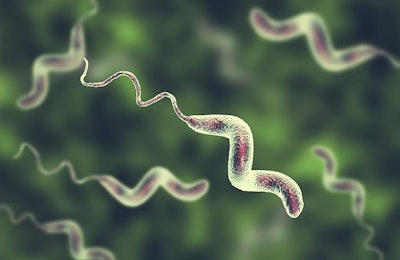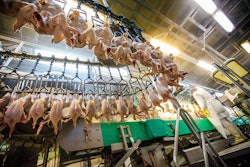
Campylobacter is the main cause of bacterial gastroenteritis in the world and researchers have shown it to be present in high levels in retail poultry. Stricter performance standards have been implemented by the U.S. Department of Agriculture (USDA) aimed at reducing the incidence of Campylobacter in processing facilities.
Introduction
Poultry processors must give serious attention to finding efficient antimicrobial treatments to be used throughout the plant. A variety of antimicrobials have been evaluated for:
- Use on poultry at various points throughout processing
- Cost effectiveness of chemicals used
- Reduction of pathogen prevalence
- Lack of damage to poultry carcasses and parts
- Effectiveness with a short contact time due to the speed of the line.
The purpose of this study was to look at brief six second multiple exposures of two successful chemicals and to determine if the sequence of immersions would enhance the effectiveness.
Methodology
Broiler thighs were inoculated with a marker strain of Campylobacter coli and then subjected to one of five different treatments. Thighs were individually immersed for six seconds in each of two sequential dips of:
- Water-water
- PpH-PpH (A low acid processing aid)
- PAA-PAA (peracetic acid)
- PpH-PAA
- PAA-PpH.
The entire process was repeated five times and the results are shown in the bar graph.

An oxidizing agent (PAA) followed by six seconds in a low acid processing chemical (PpH) resulted in reduction of Campylobacter.
Results
The sequential dip in water shows the rinsing effect. The two sequential dips in PpH is 89% and in PPA is 95.7%. Then the six second immersion in PpH followed by a six second immersion in PAA resulted in a 95.4%. The most effective sequential treatment was six seconds in PAA followed by six seconds in PpH which resulted in 99.6%, almost a 3 log reduction.
Conclusions
Scientists have determined a multi-hurdle approach is necessary for adequate pathogen reduction.
PAA is a low pH organic peroxide mixture of acetic acid and hydrogen peroxide and is currently being used throughout the United States in multiple commercial processing facilities. The mode of action for PAA is a disruption to the cell membrane permeability, altering protein synthesis, leading to bacterial death.
No published research was found demonstrating the usefulness of consecutive, sequential chemical treatments.
When faced with only a six second exposure time, which is a practical time of exposure in a modern processing facility treatment, with an oxidizing agent (PAA) followed by six seconds in a low acid processing chemical (PpH) resulted in significantly greater reduction of Campylobacter on chicken thighs.
Both chemicals are presently approved and are being used in commercial poultry processing plants. These findings may be extremely beneficial and lead to better in-plant intervention strategies for Campylobacter reduction.

















